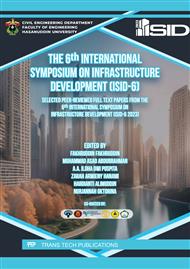[1]
M. Kadhom, N. Albayati, H. Alalwan, and M. Al-Furaiji, "Removal of dyes by agricultural waste," Sustainable Chemistry and Pharmacy, 16, 2020.
DOI: 10.1016/j.scp.2020.100259
Google Scholar
[2]
F. Amalina, A. S. A. Razak, S. Krishnan, A. W. Zularisam, and M. Nasrullah, "Water hyacinth (Eichhornia crassipes) for organic contaminants removal in water – A review," Journal of Hazardous Materials Advances, 7, 2022.
DOI: 10.1016/j.hazadv.2022.100092
Google Scholar
[3]
V. Khandegar and A. Saroha, "Electrochemical Treatment of Textile Effluent Containing Acid Red 131 Dye, 2013.
DOI: 10.1061/(ASCE)HZ.2153-5515.0000194
Google Scholar
[4]
O. T. Can, M. Kobya, E. Demirbas, and M. Bayramoglu, "Treatment of the textile wastewater by combined electrocoagulation," Chemosphere, 62,(2),181–187, 2006.
DOI: 10.1016/j.chemosphere.2005.05.022
Google Scholar
[5]
M. Nasrullah, L. Singh, S. Krishnan, M. Sakinah, D. M. Mahapatra, and A. W. Zularisam, "Electrocoagulation treatment of raw palm oil mill effluent: Effect of operating parameters on floc growth and structure," Journal of Water Process Engineering, 33, 2020.
DOI: 10.1016/j.jwpe.2019.101114
Google Scholar
[6]
S. Krishnan et al., "Chapter 2 - Application of bioelectrochemical systems in wastewater treatment and hydrogen production," in Delivering Low-Carbon Biofuels with Bioproduct Recovery, L. Singh and D. M. Mahapatra, Eds., Elsevier, 2021, 31–44.
DOI: 10.1016/B978-0-12-821841-9.00003-7
Google Scholar
[7]
R. Vidu et al., "Removal of Heavy Metals from Wastewaters: A Challenge from Current Treatment Methods to Nanotechnology Applications," Toxics,. 8 (4), 2020.
DOI: 10.3390/toxics8040101
Google Scholar
[8]
A. K. Verma, R. R. Dash, and P. Bhunia, "A review on chemical coagulation/flocculation technologies for removal of colour from textile wastewaters," Journal of Environmental Management, 93 (1), p.154–168, 2012.
DOI: 10.1016/j.jenvman.2011.09.012
Google Scholar
[9]
R. Ardhianto and A. Bagastyo, "Personal Care Wastewater Treatment With Electro-coagulation and Electro-oxidation," E3S Web of Conferences, 125, 2019.
DOI: 10.1051/e3sconf/201912503008
Google Scholar
[10]
T. Kim, T.-K. Kim, and K.-D. Zoh, "Removal mechanism of heavy metal (Cu, Ni, Zn, and Cr) in the presence of cyanide during electrocoagulation using Fe and Al electrodes," Journal of Water Process Engineering, 33, 2020.
DOI: 10.1016/j.jwpe.2019.101109
Google Scholar
[11]
A. Tahreen, M. S. Jami, and F. Ali, "Role of electrocoagulation in wastewater treatment: A developmental review," Journal of Water Process Engineering, 37, 2020.
DOI: 10.1016/j.jwpe.2020.101440
Google Scholar
[12]
S. A. Martínez-Delgadillo, H. R. Mollinedo P., M. A. Gutiérrez, I. D. Barceló, and J. M. Méndez, "Performance of a tubular electrochemical reactor, operated with different inlets, to remove Cr(VI) from wastewater," Computers & Chemical Engineering, 34 (4), 491–499, 2010.
DOI: 10.1016/j.compchemeng.2009.05.016
Google Scholar
[13]
B. K. Zaied, M. Rashid, M. Nasrullah, A. W. Zularisam, D. Pant, and L. Singh, "A comprehensive review on contaminants removal from pharmaceutical wastewater by electrocoagulation process.," Sci Total Environ, 726, 2020.
DOI: 10.1016/j.scitotenv.2020.138095
Google Scholar
[14]
T. S. A. Singh and S. T. Ramesh, "An experimental study of CI Reactive Blue 25 removal from aqueous solution by electrocoagulation using Aluminum sacrificial electrode: kinetics and influence of parameters on electrocoagulation performance," Desalination and Water Treatment, 52 (13–15), 2634–2642, 2014.
DOI: 10.1080/19443994.2013.794714
Google Scholar
[15]
S. Bener, Ö. Bulca, B. Palas, G. Tekin, S. Atalay, and G. Ersöz, "Electrocoagulation process for the treatment of real textile wastewater: Effect of operative conditions on the organic carbon removal and kinetic study," Process Safety and Environmental Protection, 129, 47–54, 2019.
DOI: 10.1016/j.psep.2019.06.010
Google Scholar
[16]
N. Modirshahla, M. A. Behnajady, and S. Mohammadi-Aghdam, "Investigation of the effect of different electrodes and their connections on the removal efficiency of 4-nitrophenol from aqueous solution by electrocoagulation," Journal of Hazardous Materials, 154 (1), 778–786, 2008.
DOI: 10.1016/j.jhazmat.2007.10.120
Google Scholar
[17]
P. K. Holt, G. W. Barton, and C. A. Mitchell, "The future for electrocoagulation as a localised water treatment technology," Chemosphere, 59(3), 355–367, 2005.
DOI: 10.1016/j.chemosphere.2004.10.023
Google Scholar
[18]
A. pakfetrat, S. Sajjadi, and M. Irani, "Removal of Remazol Black B Dye by Electrocoagulation Process Coupled with Bentonite as an Aid Coagulant and Natural Adsorbent," Iranian Journal of Health, Safety and Environment, 5, 2017.
Google Scholar
[19]
B. Louhichi, F. Gaied, K. Mansouri, and M. R. Jeday, "Treatment of textile industry effluents by Electro-Coagulation and Electro-Fenton processes using solar energy: A comparative study," Chemical Engineering Journal, 427, 2022.
DOI: 10.1016/j.cej.2021.131735
Google Scholar
[20]
M. A. Sadik, "Removal of Reactive Dye from Textile Mill Wastewater by Leading Electro-Coagulation Process Using Aluminum as a Sacrificial Anode," Advances in Chemical Engineering and Science, 9, 182–193, 2019.
DOI: 10.4236/aces.2019.92014
Google Scholar
[21]
M. Y. A. Mollah, R. Schennach, J. R. Parga, and D. L. Cocke, "Electrocoagulation (EC) — science and applications," Journal of Hazardous Materials, 84(1) 29–41, 2001.
DOI: 10.1016/S0304-3894(01)00176-5
Google Scholar
[22]
R. Ardhianto, A. D. Anggrainy, G. Samudro, A. Triyawan, and A. Y. Bagastyo, "A study of continuous-flow electrocoagulation process to minimize chemicals dosing in the full-scale treatment of plastic plating industry wastewater," Journal of Water Process Engineering, vol. 60, p.105217, 2024.
DOI: 10.1016/j.jwpe.2024.105217
Google Scholar


